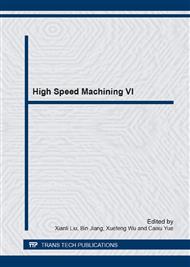[1]
Zhenyu Sing. Study on micro mechanism of cutting thickness based on minimum excision. (shandong; Doctoral Dissertation of Shandong University. 2011).
Google Scholar
[2]
M. P. Vogler, R. E. Devor,S. G. Kapoor. On the modeling and analysis of machining performance in micro-endmilling, PartI: surface generation[J]. ASME J. Manuf. Sci. Eng. 126(2004)685-694.
DOI: 10.1115/1.1813470
Google Scholar
[3]
G. Bissacco, H. N. Hansen, J. Slunsky. Modeling the cutting edge radius size effect for force prediction in micro milling[J]. Annals of the CIRP. 57 (2008)113-116.
DOI: 10.1016/j.cirp.2008.03.085
Google Scholar
[4]
S. Shimada, N. Ikawa, H. Tanaka,Ohmori. Feasibility study on ultimate accuracy in microcutting Using Molecular Dynamics Simulation[J]. CIRP Annals-Manufacturing Technology. 42(1993)92-94.
DOI: 10.1016/s0007-8506(07)62399-3
Google Scholar
[5]
Z.J. Yuan, M. Zhou, S. Dong. Effect of diamond tool sharpness on minimum cutting thickness and cutting surface integrity in ultraprecision machining[J]. Joumal of Materials Processing Technology. 62 (1996)327-330.
DOI: 10.1016/s0924-0136(96)02429-6
Google Scholar
[6]
Linhu Tang, Jianlong Huang, Liming Xie. Finite element modeling and simulation in dry hardorthogonal cutting AISID2 tool steel with CBN cutting tool[J]. Int J Adv Manuf Technol . 53 (2011)1167-1181.
DOI: 10.1007/s00170-010-2901-2
Google Scholar
[7]
K.S. Woon, M. Rahman, K.S. Neo. The Effect of Tool Edge Radius on The Contact Phenomenon of Tool-based Micromaching[J]. International Journal of Machine Tools and Manufacture. 48(2009)1395-1407.
DOI: 10.1016/j.ijmachtools.2008.05.001
Google Scholar
[8]
Jing Ma. Under the condition of deformation of the tool die steel milling prediction considering the limit cutting depth. (haerbin, Master's degree thesis of Harbin University of Science and Technology, 2014).
Google Scholar


